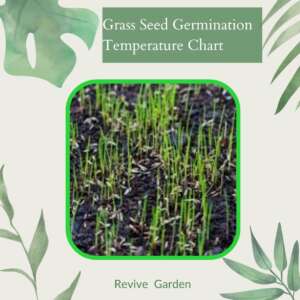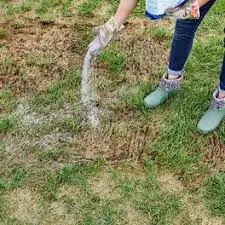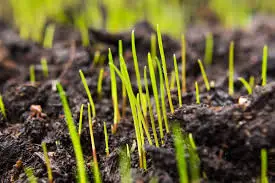Table of Contents
 Everyone yearns for a thick, lush, healthy lawn, but achieving this ideal isn’t always straightforward. Planting grass seed at the right time of year and with the right tools is essential for the success of your lawn.
Everyone yearns for a thick, lush, healthy lawn, but achieving this ideal isn’t always straightforward. Planting grass seed at the right time of year and with the right tools is essential for the success of your lawn.
If you want to get the most out of your grass seed investment and avoid wasting it, read on to learn the optimal germination temperature.
This article will provide you the accurate information about seed germination, optimal temperature of the soil, and suitable time for different types of grass. I hope you will find it beneficial.
So, Let’s start!
How grass seeds germinate
Germination is an easy process to understand. The testa is the tough outer shell of a seed. The micropyle is a hole in the testa that allows water to enter the seed in correct conditions. The chemical reaction initiated by the water inside the seed enables the plumule and radicle to break through the testa (now pliable from the absorbed water) and emerge into the soil.
Once the seedling’s root system has developed enough to absorb water, the shoot can begin photosynthesis, creating energy and weaning the plant off its supply.
Things to consider before selecting your Grass Seed
When selecting when to seed your grass, you should consider the following.
Seasonal Considerations

- After raking their yards and discovering bare spots, most homeowners immediately put grass seed in the spring. The issue is that spring weather can be highly variable even in the same region.
- The rainy and chilly spring weather is the leading cause of grass seed not germinating. Sowing grass seed in soil with a temperature of fewer than 50 degrees Fahrenheit might delay germination for weeks, if not prevent it altogether.
- Ten days of temperatures of 65 degrees or higher are required for the soil to warm to above 50 degrees.
- The spring season is also infamously wet. The grass seed germination requires water, but there might be too much of a good thing. Rainfall during the spring can cause grass seeds not to germinate right away.
- It would be best to consider the time of year you plant your grass seeds and the time it takes for the grass to grow naturally. Grasses have varying seasonal growth preferences.
- Certain types of grass may germinate and expand their territory more effectively in warmer temperatures, while other types may do better in cooler climates. Knowing your seeds and the sort of grass you are cultivating can help you choose the best planting time.
Temperature for Warm Season Grasses
Soil temperatures must be at least 50 degrees Fahrenheit for spring seeds and dormant seeds to germinate. The sweet spot is between 50 and 65 degrees (measured at a depth of 2 inches). Once the soil reaches this temperature, the germination process can begin.
Most people don’t comprehend that just because the air is warm (say, 75 degrees) doesn’t indicate the soil is warm (also typically not 75 degrees). Ideally, we’d have air temperatures consistently 10 degrees higher than the required soil temperature.
Air temperatures of around 60–75 degrees Fahrenheit must be maintained for an extended period if, for instance, soil temperatures rise to 50–65 degrees Fahrenheit
Temperature for Cool Season Grasses
The soil temperature determines whether or not grass seeds will germinate. Seeds of cool-season grasses sprout best in soils between 50 and 65 degrees Fahrenheit (10 and 18 degrees Celsius). At soil temperatures between 65 and 70 degrees Fahrenheit (18 and 21 degrees Celsius), warm-season grass seed thrives.
Cool-season grasses, which thrive in cooler temperatures, should be sown in the fall, about six weeks before the first average frost. With the support of a growth spurt in the fall and another in the spring, grass can make it through the scorching summer.
It is the right time of year to sow warm-season grasses. After a successful spring and summer, the grass will be well-established enough to withstand the cold of the coming winter.
Comparison of fall vs. the spring for Seed Germination

The best time to plant seeds for cool-season grasses is in the fall when they will germinate and proliferate before winter and again in the spring. Planting warm-season grass seeds in the spring ensure that they will grow and increase throughout the summer.
Fall Season
Seeding cool-season grass in the spring is not ideal since the grasses’ development rates slow down or they refuse to germinate due to high temperatures. Seeding warm-season grasses in the fall may result in weak grass seedlings that cannot survive the winter because the growth and germination of these grasses slow or stop as temperatures cool.
Spring Season
Seeding cool-season grasses in the fall are recommended. Plant seeds at least two months before the expected first frost. Go dormant when the ground cools to 40 degrees Fahrenheit (4 degrees Celsius).
When the soil temperature reaches 90 degrees Fahrenheit (32 degrees Celsius), you should go into dormancy. You can maintain a green lawn all year long by overseeding in the fall with cool-season grass in areas where warm-season grasses die back in the winter.
Optimum Temperatures for Seed Germination |
|
Turf grass Species |
Optimum temperatures |
| Kentucky bluegrass | 59-86 |
| Bermuda | 68-86 |
| Red fescue | 59-77 |
| Sheep fescue | 59-77 |
| Chewings fescue | 69-77 |
| Annual bluegrass | 68-86 |
| Creeping bentgrass | 59-86 |
| Tall fescue | 68-86 |
Numbers Separated by a dash, are the temperatures imply a gradual shift. Assuming that the first number represents temperatures for roughly 16 hours and the second for approximately 8 hours, we can infer that the first number means temperatures that are typically cooler in the evening and early morning and that the second number represents temperatures that generally are cooler during the middle of the day.
Keep in Mind the Role of Water and Soil Contact in Seed Development
When planting grass seed, do not bury it more than half an inch below the earth’s surface, and water it regularly the top inch of soil. Your dream of thick, green grass might become a reality with regular irrigation and the right temperature conditions.
Conclusion
This article presented the complete process of seed germination, its growth in favorable environment and temperature according to different types of grass including cool season and warm season grasses. I hope you find it helpful.
